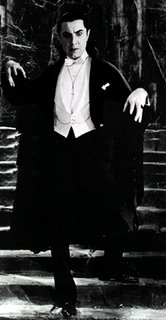'I am . . . Dracula'

Bela Lugosi was born Bela Blasko on this day in 1882 in Lugos, Hungary, less than 50 miles from Transylvania.
Bela Blasko dropped out of school early and worked in mines and on railroads until, preparing himself by compulsive self-education, he began to act in small traveling repertory companies around Hungary around 1902. By 1911, he had enough of a reputation as a matinee idol, eliciting critical praise as "Romeo" in Shakespeare's Romeo and Juliet in Szeged, to be invited to apprentice at the National Theater of Budapest.
With the outbreak of World War I, Lugosi (as he was now known) fought in Austria-Hungarian Army, suffering near fatal wounds in the Carpathian Mountains. After the War came the Revolution, which Lugosi actively supported, with the result that he became a fugitive from counterrevolutionary forces along with countrymen Paul Lukas, Alexander Korda and Michael Curtiz.
At 38, he eventually found himself in the U.S., an unemployed actor who didn't know English. Luckily, film work in America in the 1920s didn't require him to speak English, so he began to glower his way through a series of villain roles in silent films, such as the spy in The Silent Command (1923). Though he resisted taking the part, he ended up playing the role of "Count Dracula" in a Broadway stage version of Bram Stoker's Dracula in 1927, which led to his being cast as the vampire-prince in Tod Browning's 1930 film version.
He was a sensation in the role: with his sharp features, piercing eyes and the thick, mysterious Magyar accent, the effect was chilling; yet, it should come as no shock that 97% of his fan mail after Dracula came from women, for he played Dracula as though he were Valentino. (The rest of his fan mail apparently came from scientists and priests asking for his views on spiritualism.)
For the rest of his life, Lugosi would only play roles which were variations on Dracula -- vampires, psychotic killers and mad scientists -- despite furious effort on Lugosi's part, who desired to be given a chance as a serious actor (he even went so far as to publish a photograph of himself as Jesus, whom he played on stage in 1916, in a 1930 casting directory). Universal Pictures tried to get him to play the monster in Frankenstein, but he resisted (the role would make Boris Karloff a star), and his career went into a slow, agonizing slide, degenerating into self-parody (such as his appearances in Old Mother Riley Meets the Vampire and Bela Lugosi Meets a Brooklyn Gorilla, both 1952).
With his personal life in a shambles, Lugosi became a drug addict. He was at rock-bottom when he met Edward D. Wood, an aspiring bad filmmaker, who bought Lugosi formaldehyde to quench his thirst and cast him in some truly awful pieces of cinema: Glen or Glenda? (1953), Bride of the Monster (1955) and, posthumously, Plan 9 From Outer Space (1959). At the end, Lugosi went into rehab (courageously owning up to his problem during a time when it was not at all popular to do so), kicked his habit and married for the fifth time (happily) before dying of a heart attack on August 16, 1956. He was buried in Holy Cross Cemetery, Los Angeles, wearing his famous vampire cape.
Labels: Classic Cinema





1 Comments:
Couldn't resist this one:
Lugoj! The town in Romania (just 60 km from my house by the way) is a sleepy little place - not much to go there for other than a great pancake house - traditional Romanian stuffed pancakes being one of the delights of the region.
Good wine nearbye.
And Old Mother Riley - English Cross Dressing at its best.
Post a Comment
Subscribe to Post Comments [Atom]
<< Home